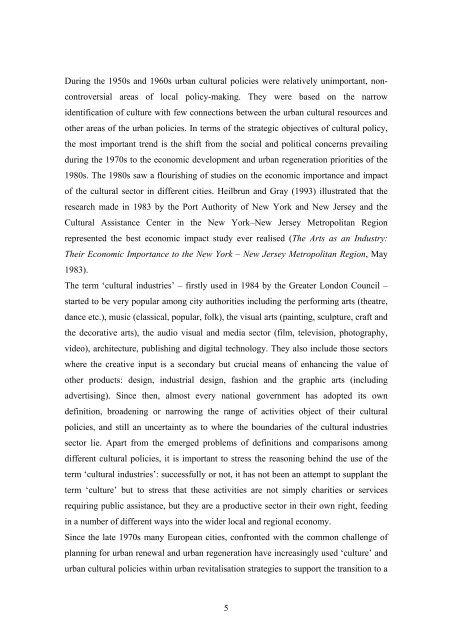Paper - Fokus
Paper - Fokus
Paper - Fokus
Create successful ePaper yourself
Turn your PDF publications into a flip-book with our unique Google optimized e-Paper software.
During the 1950s and 1960s urban cultural policies were relatively unimportant, noncontroversialareas of local policy-making. They were based on the narrowidentification of culture with few connections between the urban cultural resources andother areas of the urban policies. In terms of the strategic objectives of cultural policy,the most important trend is the shift from the social and political concerns prevailingduring the 1970s to the economic development and urban regeneration priorities of the1980s. The 1980s saw a flourishing of studies on the economic importance and impactof the cultural sector in different cities. Heilbrun and Gray (1993) illustrated that theresearch made in 1983 by the Port Authority of New York and New Jersey and theCultural Assistance Center in the New York–New Jersey Metropolitan Regionrepresented the best economic impact study ever realised (The Arts as an Industry:Their Economic Importance to the New York – New Jersey Metropolitan Region, May1983).The term ‘cultural industries’ – firstly used in 1984 by the Greater London Council –started to be very popular among city authorities including the performing arts (theatre,dance etc.), music (classical, popular, folk), the visual arts (painting, sculpture, craft andthe decorative arts), the audio visual and media sector (film, television, photography,video), architecture, publishing and digital technology. They also include those sectorswhere the creative input is a secondary but crucial means of enhancing the value ofother products: design, industrial design, fashion and the graphic arts (includingadvertising). Since then, almost every national government has adopted its owndefinition, broadening or narrowing the range of activities object of their culturalpolicies, and still an uncertainty as to where the boundaries of the cultural industriessector lie. Apart from the emerged problems of definitions and comparisons amongdifferent cultural policies, it is important to stress the reasoning behind the use of theterm ‘cultural industries’: successfully or not, it has not been an attempt to supplant theterm ‘culture’ but to stress that these activities are not simply charities or servicesrequiring public assistance, but they are a productive sector in their own right, feedingin a number of different ways into the wider local and regional economy.Since the late 1970s many European cities, confronted with the common challenge ofplanning for urban renewal and urban regeneration have increasingly used ‘culture’ andurban cultural policies within urban revitalisation strategies to support the transition to a5




